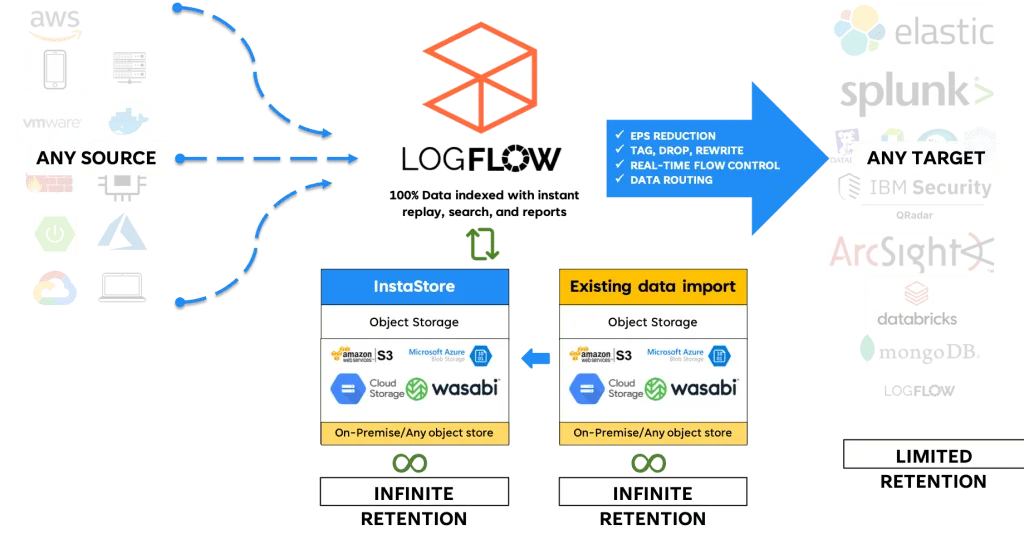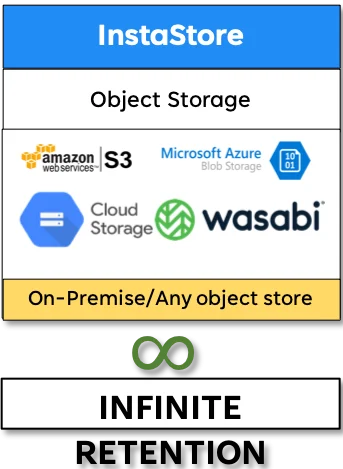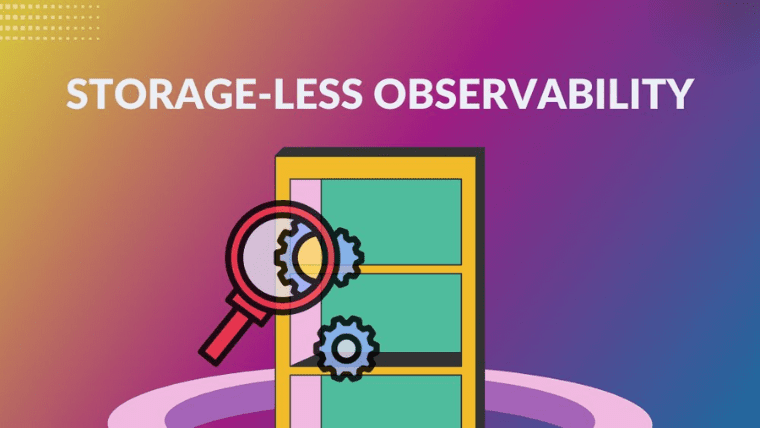In today’s data-driven world, the need for comprehensive observability has never been greater. Organizations rely on observability to gain insights into their systems’ and applications’ performance, availability, and behavior.
However, the traditional approach to observability, which involves ingesting, processing, and storing massive amounts of data, is becoming increasingly challenging and expensive.
This article explores the benefits of a storage-less architecture for observability and highlights how apica.io’s InstaStore addresses these challenges, offering improved agility, automation, compliance, and cost-effectiveness.
But first, let’s look at what storage-less architecture means.
What is Storage-less Architecture?
A storage-less architecture refers to an approach where users are relieved from the concerns related to the underlying physical infrastructure components.
Instead, an automated orchestration system takes care of mapping and managing the resources across the infrastructure. This enables the infrastructure to be distributed, diverse, and scalable in addition to avoiding adding unnecessary complexity.
In simpler terms, storage-less architecture allows you to focus on your applications without worrying about the physical infrastructure.
The Challenges of Traditional Observability
Traditional observability methods often face several challenges that hinder their effectiveness. These challenges include limited data collection, lack of real-time insights, and difficulties in correlating different sources of information.
The following challenges highlight the need for more advanced observability solutions that can overcome limitations and provide comprehensive, real-time insights into complex systems:
1. Escalating Complexity
With the exponential growth of data, traditional observability architectures struggle to handle the increasing complexity of ingesting, processing, and storing massive volumes of data. This complexity can lead to performance bottlenecks, scalability limitations, and increased maintenance efforts.
2. Cost and Scalability
Storing and managing vast amounts of observability data can quickly become cost-prohibitive. As data volumes and velocities continue to rise, organizations face the challenge of scaling their storage infrastructure while maintaining reasonable costs.
3. Data Integrity
Ensuring 100% data integrity is crucial for accurate observability. However, as data is ingested, transformed, and stored across different systems, there is an inherent risk of data corruption or loss, potentially leading to inaccurate insights and compromised decision-making.
The Benefits of a Storage-less Architecture in Observability

A storage-less architecture offers numerous benefits for observability initiatives, such as:
- Agility: Storage-less architecture enables real-time data processing, faster decision-making, and prompt response to changing requirements.
- Automation: Eradicates the need for manual management of storage infrastructure, ensuring efficient data ingestion, processing, and analysis while reducing human errors.
- Compliance: Reduces the risk of storing sensitive data for extended periods, ensuring adherence to regulatory standards through object storage, encryption, and access control.
- Cost-effectiveness: Eliminates upfront hardware investments and reduces ongoing storage maintenance costs, allowing organizations to achieve more with the same budget by leveraging the scalability and cost-effectiveness of object storage.
How Apica’s InstaStore uses Storage-less Architecture
InstaStore is a new novel storage paradigm built by apica.io to meet the demands of modern high-volume business environments. InstaStore runs on top of any object storage.
Traditional observability architectures are hampered by storage operations overheads at scale. Running out of disk space is all too common. Node failures and storage recovery are commonplace.
Tiered storage to solve these challenges introduces even more complexity without any immediate benefits. All these issues force teams to spend an inordinate amount of time dealing with storage operations vs focusing on their core expertise and business problems.

Benefits of InstaStore Storage-less Architecture
“With InstaStore, there is no need to worry about data obstruction or loss.”
InstaStore was specifically designed to address the difficulties encountered by businesses operating in fast-paced, high-volume settings.
Every piece of information that enters our LogFlow system is guaranteed to be stored in InstaStore before being transmitted further.
It revolutionizes storage by offering an unlimited storage layer that functions as an application programming interface (API), seamlessly integrating with various object stores.
Right from the start, you can establish your data pipelines with the advantage of unlimited storage, enabling it to serve as an infinite repository that accommodates any inconsistencies in data throughput between the data source and destination.
The beauty lies in its ability to promptly replay any data stored within, allowing instantaneous delivery to a designated target whenever needed.
Following are the key benefits of InstaStore’s storage-less architecture for leveraging your Observability game:
1. Simplicity: With a storage-less architecture powered by InstaStore, the entire data flow is managed seamlessly without the need for secondary storage tiers.
All data is stored in the object storage as primary data, eliminating the complexity of managing multiple storage layers. This simplifies the observability platform and reduces operational overhead.
2. Query Readiness: InstaStore ensures that all data is fully indexed, searchable, comparable, and minable in real time.
This enables users to quickly and efficiently query and analyze data, gaining valuable insights and facilitating faster decision-making.
3. Speed: Whether it is old or new data, the Time to First Byte (TTFB) remains the same. InstaStore provides real-time access to data, ensuring that the retrieval speed is consistent, regardless of the data’s age. This enhances the overall performance and responsiveness of the observability platform.
4. Time Travel: InstaStore enables users to go back in time and replay any old data to any target at any time. This feature is precious for retrospective analysis, troubleshooting, and historical comparisons.
Moreover, the ability to access and analyze past data enhances the understanding of system behavior and aids in identifying patterns and trends.
5. Data Ownership: One of the significant advantages of InstaStore is that 100% of the data belongs to the user, not apica.io. This ensures data privacy and security, giving organizations full control over their data and complying with data governance and compliance requirements.
6. Efficiency: By eliminating storage management projects, InstaStore frees up valuable time and resources for observability teams.
The storage-less architecture reduces the need for manual intervention in storage operations, allowing teams to focus on their core expertise and solve business problems effectively.
7. Openness: InstaStore adopts an open data format, eliminating vendor lock-in. This guarantees future readiness and the ability to seamlessly integrate with other systems or tools.
Organizations can leverage the benefits of a storage-less architecture without being tied to a specific vendor or technology.
8. Flexibility: It is designed to work seamlessly with environments of any size, accommodating small-scale setups to large-scale enterprise deployments.
The storage-less architecture offers flexibility and scalability, ensuring the observability platform can adapt and grow alongside the organization’s needs.
Conclusion
In the era of exploding data, observability requires a paradigm shift to effectively handle the challenges of data volumes, complexity, and costs.
A storage-less architecture like Apica’s InstaStore, brings significant advantages to observability initiatives. By offering agility, automation, compliance, and cost-effectiveness, it enables organizations to overcome the limitations of traditional observability approaches.
Embracing a storage-less architecture empowers teams to focus on extracting meaningful insights from real-time data, leading to improved system performance, enhanced decision-making, and ultimately, better business outcomes in today’s data-intensive landscape.
apica.io’s InstaStore is the perfect solution for any company looking to take advantage of the power of storage-less observability. By leveraging its unique features and capabilities, organizations can quickly gain insight into their data, improve decision-making, and achieve better outcomes.
So why wait? Start your journey towards storage-less observability today!











